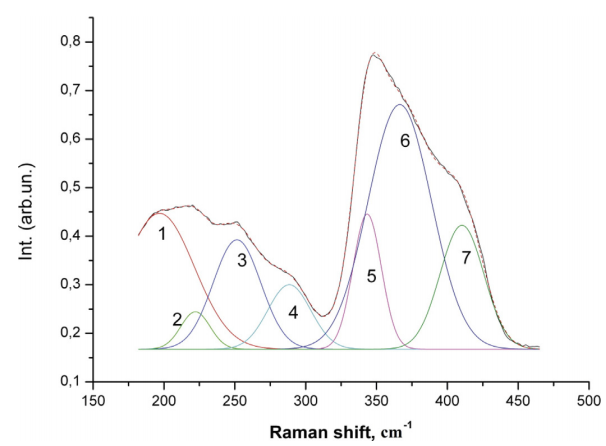- Details
- Hits: 1080
Scientific Reports 7, Article number: 41991, Pages 1-10
E.G. Vlakh, E.V. Grachova, D.D. Zhukovsky, A.V. Hubina, J.R. Shakirova, A.S. Mikhailova, V.V. Sharoyko, S.P. Tunik, T.B. Tennikova
Self-assemble nanoparticles based on polypeptides containing C-terminal luminescent Pt-cysteine complex
Scientific Reports 7, Article number: 41991, Pages 1-10
DOI: 10.1038/srep41991

The growing attention to the luminescent nanocarriers is strongly stimulated by their potential application as drug delivery systems and by the necessity to monitor their distribution in cells and tissues. In this communication we report on the synthesis of amphiphilic polypeptides bearing C-terminal phosphorescent label together with preparation of nanoparticles using the polypeptides obtained. The approach suggested is based on a unique and highly technological process where the new phosphorescent Pt-cysteine complex serves as initiator of the ring-opening polymerization of α-amino acid N-carboxyanhydrides to obtain the polypeptides bearing intact the platinum chromophore covalently bound to the polymer chain. It was established that the luminescent label retains unchanged its emission characteristics not only in the polypeptides but also in more complicated nanoaggregates such as the polymer derived amphiphilic block-copolymers and self-assembled nanoparticles. The phosphorescent nanoparticles display no cytotoxicity and hemolytic activity in the tested range of concentrations and easily internalize into living cells that makes possible in vivo cell visualization, including prospective application in time resolved imaging and drug delivery monitoring.
- Details
- Hits: 1156
Journal of Non-Crystalline Solids 457 (2017) 164–168
D.V. Pan'kin, М.V. Sukhanov, Yu.S. Tver'yanovich, М.F. Churbanov
«Investigation of structure of GeS1.35 glasses with the use of isotopically enriched germanium and Raman scattering spectroscopy»
Journal of Non-Crystalline Solids 457 (2017) 164–168
DOI: 10.1016/j.jnoncrysol.2016.11.038

The samples of GeS1.35 glasses were synthesized with germanium and sulfur of natural isotopic composition and with isotopically enriched germanium (72Ge, 74Ge, 76Ge). The glasses were investigated by the method of Raman scattering spectroscopy (RSS). It was shown that GeS4/2 tetrahedrons and structural units containing Ge\\Ge homobonds are present in glasses. The quantum-mechanical calculation of the frequency of fundamental vibrational modes in glass network was carried out. Their dependencies on the atomic mass of germanium were used for identification of bands in RS (Raman scattering) spectra.
- Details
- Hits: 1106
Dalton Transactions Issue 8, Pages 2516-2523
J.R. Shakirova, E.V. Grachova, V.V. Sizov, G.L. Starova, I.O. Koshevoy, A.S. Melnikov, M.C. Gimeno, A. Laguna, and S.P. Tunik
Polynuclear cage-like Au(I) phosphane complexes based on S2− template: observation of multiple luminescence in coordinated polyaromatic systems
Dalton Transactions Issue 8, Pages 2516-2523
DOI: 10.1039/C6DT04126D

A rational approach to the synthesis of cage-like compounds has been realized to build a new family of sulfido-phosphane Au(I) polynuclear complexes. Ditopic phosphane ligands with an extended aromatic system were used to obtain cage compounds with a clearly determined geometry. Au(I) complexes have been fully characterised in solution using spectroscopy methods, and DFT optimisation of the molecular structure gives additional arguments in favour of the suggested structural patterns. All complexes obtained are luminescent in solution and in the solid state, and display multiple emissions with an unusual combination of two phosphorescence bands and one fluorescence band. DFT calculations show that multiple emissions were mainly determined by 1IL and metal perturbed 3IL transitions. The ratio of singlet and triplet emission components depends on the distance between the ligand chromophoric centre and Au(I).
- Details
- Hits: 1079
Optical and Quantum Electronics Volume 49, No.1, January 2017, Article 40, Pages 1-9
E. I. Ageev, D. V. Potorochin, D. V. Sachenko, G. V. Odintsova
Generation of web-like structures and nanoparticles by femtosecond laser ablation of silicon target in ambient air
Optical and Quantum Electronics Volume 49, No.1, January 2017, Article 40, Pages 1-9
DOI: 10.1007/s11082-016-0875-5

Silicon nanoparticles were produced by femtosecond laser ablation in ambient air. Obtained samples were studied using dark-field optical microscopy, scanning electron microscopy and Raman-scattering spectroscopy. Two groups of structures can be found: (1) branched amorphous structures with a minimum element size of about 10 nm and incorporations of nanocrystals (0.6–6.6 nm from Raman scattering analysis); (2) larger crystal particles with smooth surface and a typical size of 50–200 nm that provide directional visible light scattering (at dark-field optical microscopy observations). An influence of environment on resulting phase composition of silicon nanoparticles was investigated by numerical evaluation of nanoparticle’s cooling rate. The calculation shows that cooling in ambient air ensures cooling rate sufficient for crystallization.
- Details
- Hits: 1124
Semiconductors Volume 51, No. 1, January 2017, Pages 111–115
D. A. Kudryashov, A. S. Gudovskikh, A. V. Babichev, A. V. Filimonov, A. M. Mozharov, V. F. Agekyan, E. V. Borisov, A. Yu. Serov, and N. G. Filosofov
Nanoscale Cu2O Films: Radio-Frequency Magnetron Sputtering and Structural and Optical Studies
Semiconductors Volume 51, No. 1, January 2017, Pages 111–115
DOI: 10.1134/S1063782617010110

Nanoscale copper (I) oxide layers are formed by magnetron-assisted sputtering onto glassy and silicon substrates in an oxygen-free environment at room temperature, and the structural and optical properties of the layers are studied. It is shown that copper oxide formed on a silicon substrate exhibits a lower degree of disorder than that formed on a glassy substrate, which is supported by the observation of a higher intensity and a smaller half-width of reflections in the diffraction pattern. The highest intensity of reflections in the diffraction pattern is observed for Cu2O films grown on silicon at a magnetron power of 150 W. The absorption and transmittance spectra of these Cu2O films are in agreement with the well-known spectra of bulk crystals. In the Raman spectra of the films, phonons inherent in the crystal lattice of cubic Cu2O crystals are identified.
- 10.01.2017 Acknowledging publications
- 06.01.2017 Acknowledging publications
- 23.09.2016 Participation in the St. Petersburg International Innovation Forum
- 20.09.2016 laboratory of Raman scattering have replenished by Raman spectrometer Horiba Jobin-Yvon LabRam HR800
- 12.09.2016 Commissioning of the Shimadzu UV-3600 spectrophotometer for operation in the UV, visible and near-IR spectral range








